Schizophrenic Doctrine: Why We Need to Separate Democratization Out of Stability and COIN Doctrine
Stan Wiechnik
Introduction
In the last twelve years the United States conducted two large-scale Counterinsurgency (COIN) and Stability Operations in Iraq and Afghanistan. During this period we basically wrote or rewrote our doctrine on both types of operations. But we were not simply conducting COIN and Stability Operations. We were, in fact, conducting two of the largest sociopolitical experiments ever attempted in recent times. We attempted to forcibly alter an entire society’s political system. The effort involved removing the existing autocratic governments of Iraq and Afghanistan and installing democratic ones. Promoting democracy is part of America’s foreign policy and our military doctrine is designed to advocate for this policy.[1] It was also our mission to ensure local stability. Stability is necessary to ensure that the governments of Iraq and Afghanistan do not collapse, allowing the countries to become safe havens for terrorists or other extremists. If we do the job right the governments we leave behind should not suffer from political unrest after we depart. I think it is fair to say that we did not achieve these political objectives. Neither Iraq nor Afghanistan is both democratic and stable.
American doctrine does not include a manual on Democratization. Instead both our Stabilizations Operations manual and our COIN manual imply that democratic institutions be established as part of achieving success. Both doctrines identify democratic principles as part of the solution to the problems of instability and insurgency. Political legitimacy is closely tied to democratic principles. It becomes difficult to tell where democratization ends and stabilization or counterinsurgency begins. In essence, we are trying to do democratization at the same time we are doing stabilization or counterinsurgency, but is that what we should be doing? Would it not make more sense to separate democratization tasks out?
In this paper I argue that democratization should be separated out from stabilization and counterinsurgency operations. In order to make the argument for separating democratization from COIN and stabilization I must demonstrate that certain democratic principles are not always seen as legitimate by a country’s population. That by advancing these principles we are creating more insurgents and fomenting instability. In “Political Legitimacy and Values” I argued that societal values directly affected political regime type.[2] Societies with values systems based on group identity resulted in a political legitimacy that was duties-based. These societies tended to support less democratic systems like monarchies and theocracies. Societies with values systems based on individual identity resulted in rights-based political legitimacy, which preferred representative or democratic governance. The connection between values and political legitimacy means that in order to persuade a population to accept a representative form of government part of your effort needs to be centered on changing the population’s value structure. Until that change occurs no truly democratic system can take hold. If political legitimacy is tied to values then it may not always be possible to both have a functioning democracy and stability. The very fact that the government is advocating policies that are contrary to the population’s values means that they will never accept it as legitimate. It means that, in certain circumstance, you cannot have both liberal democracy and stability.
To demonstrate why this is the case this paper expands on the connection between values and democracy laid out in theory in “Political Legitimacy and Values”. In Section I will use open-source data sets to demonstrate the connection between needs, values and political systems. I expand on how the relationship works in Section II. Based on the principles identified in the first two sections I will make recommendations on changes to our current military doctrine. For those of you who fall asleep reading sociopolitical theory and roll your eyes at psychobabble I strongly suggest you scan figures 6 and 7 and table 2 and then jump ahead to Section III. Come back to Section’s I and II if you are curious about the sociopolitical underpinnings of my arguments.
Section I. Values and Political Systems
I start with the meat of the sociopolitical argument: there is a natural connection between needs, values, and government type. This connection means that what form of government a population will find to be legitimate is dependent in part on the conditions the people are living in and the values they hold dear. The central idea is that as human living conditions improve the society’s needs change. The change in needs alters the value system of the society. As the value system changes so too does the society’s source of political legitimacy, which ultimately results in a change in political ideology. It is a three-step process: first living conditions improve, then the value system changes from communal values centered on group survival to individualistic values based on personal growth and freedoms, and then the people prefer a more democratic governance system.
To test this hypothesis I will use two data-points. The first is a nation’s Human Development Index (HDI). Developed by Pakistani economist Mahbub ul Haq and his team in 1990 the index was designed to move away from simple economic factors like Gross Domestic Product (GDP) and center instead on measuring the improvements in human well-being.[3] The HDI measures three factors; long life as measured by life expectancy at birth, education level as measured by mean literacy level, and economic security as measured by a combination of GDP and purchasing parity.[4]
The second data-point is a derived from World Values Survey (WVS) data.[5] The world values survey is conducted once every five years or so and includes data from over 80 countries. It asks a series of questions to determine the values that are most important to the society. Dr. Ronald Inglehart and Dr. Christian Welzel have used the data from these surveys to produce dimensions that can be used to estimate societal values.[6] The Traditional vs. Secular dimension reflects a contrast between societies where religion and tradition is very important versus those where they play less of a role in determining an individual’s personal values. Survival vs. Self-expression dimension reflects a distinction between those societies that emphasize economic and physical security to versus those that find subjective well being to be more important. Combined the two provide a basic yardstick for measuring whether a society has communal/survival values or whether the society has individualistic/liberal values.
The WVS data is only available for five periods of time. Based on that limitation I have plotted the HDI versus Inglehart and Welzel’s bi-dimensional values index for countries and for years in which full data from both sources are available. Each of the charts below represents a country’s values and HDI for a specific point in time. The data used for the 1990, 2000, and 2005 charts used the post-2011 HDI calculations. A second 1990 chart is included for reference to demonstrate that the changes in HDI calculation to not significantly affect the pattern of the scatter plot. Using the mean for HDI and values as the center point, each graph can be broken down into four quadrants representing, in clockwise order starting at the top right; Individualistic values and a high HDI, Individualistic values and a low HDI, communal values and a low HDI, and communal values and a high HDI. The results are in figures 1-5 below. Figure 6 is a time-lapsed scatter plot. It uses the values from 1980-81 with the HDI from 2000 to see if it represents a greater correlation.
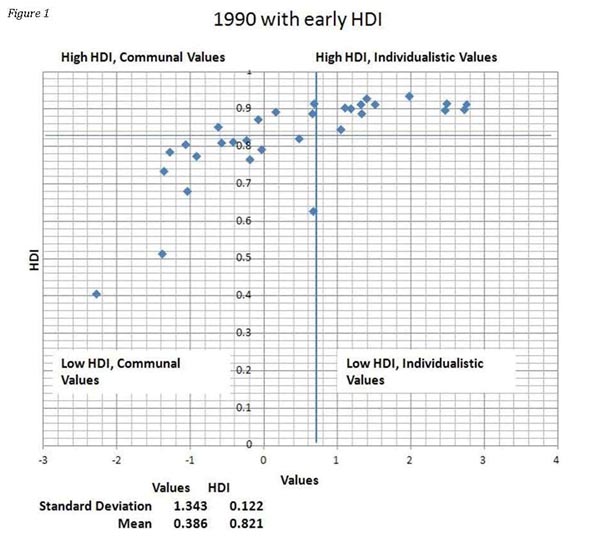
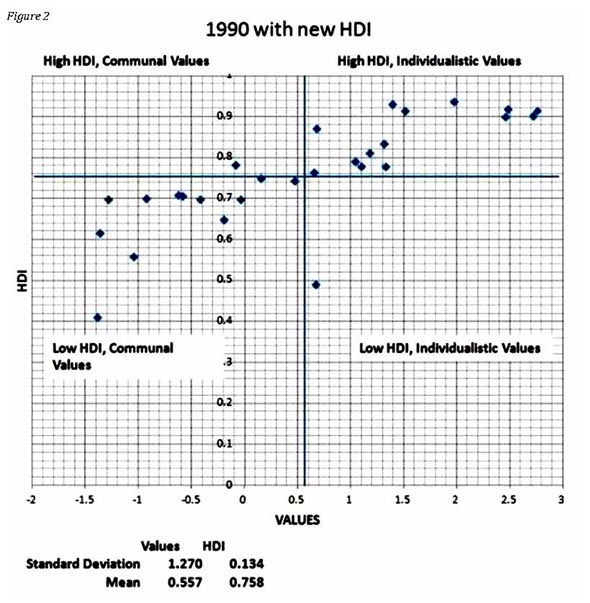
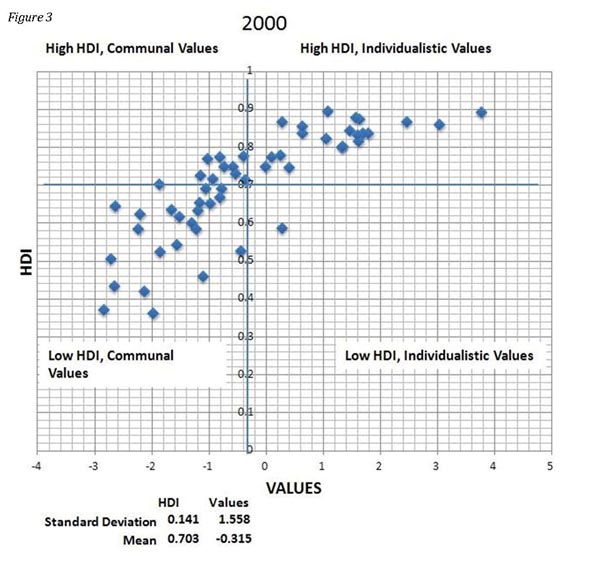
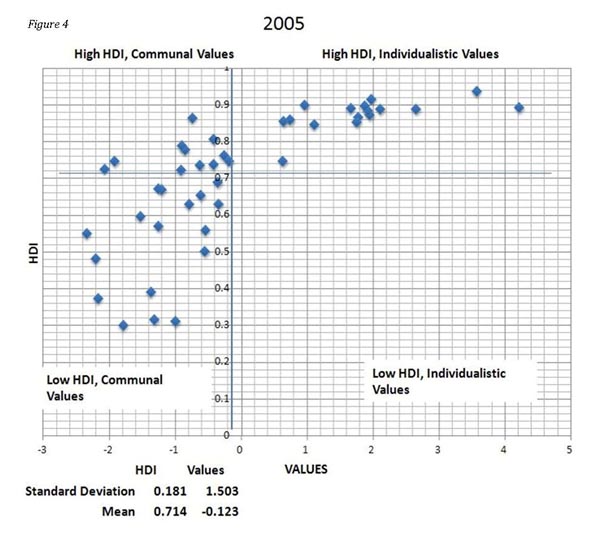
Discussion
Looking at the graphs a “stair-step” pattern becomes clear. As the social conditions of the population improve it reaches a point where the social values shift from a communal value system to an individualistic one. This matches Maslow’s ideas on needs. Once lower level needs are met and the population sees that there is a real possibility for achieving higher level needs, then these needs become the focal point of a larger part of society. The result is a shift in the value system preferred by the population from a communal system to an individualistic one. This is not a slow change in values as the social conditions improve creating a clean, linear progression. If that were the case the points would be form a linear cloud from the bottom left quadrant to the upper right quadrant. Instead, the conditions must continue to improve and until it hits a certain psychological level. This level represents a combination of improved societal conditions and the belief that higher levels needs are achievable. Once this point has is met and it remains there for a long enough time that a new generation grows up under more affluent conditions the values of ole no longer correspond to the need satisfaction the new generation is looking to pursue. With this change in need focus come a change in values. Their ideas change to a new value structure. The result is the stair-step pattern represented in the figures.
The argument that there is first a change in social conditions and then a change in values is also bolstered by the results of the time-elapse graph. The next chart demonstrates the path countries take as their conditions get better. Again it demonstrates a stair-step pattern. Countries on the left move in a generally vertical direction with regards to HDI with no particular shift in values one way or the other: movement both towards and away from individualism can be found. However, once they crest a certain point in both HDI and values the movement is generally towards higher individualistic values. Although there can be pullbacks, once a country crosses the line between communal and individualistic values they don’t return to the communal values where the HDI remains high.[7]
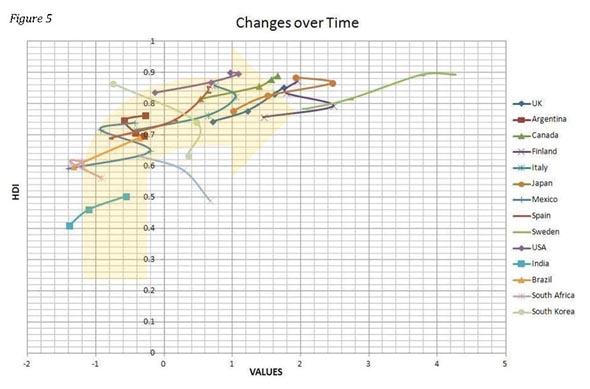
Second, it is worth noting that there are no “low HDI individualists”. Despite a relatively large standard deviation the Low HDI – Individualistic Values quadrant is virtually empty. This quadrant represents an abnormal state of affairs for humans. Because they follow a needs hierarchy and values are the result of needs, it would be a rare instance where a population’s values would stand in opposition to the needs they are most concerned with. As long as they are primarily concerned with survival needs they will not be able to transition to autonomy needs and to their corresponding individualistic values.
Finally, even though the arrow in Figure 5 is pointing up and to the right, indicating a transition from Low HDI – Communal Values to High HDI – Individualistic Values, should the arrow reverse itself it is probable that over time, with the uncertainties of life common in a Low HDI environment, the result would be a shift in the values of the population to a more communal value structure. This is the greatest distinction between this theory and Modernization theory which tends to treat the transition to individualistic systems (capitalism and democracy) as revealed truth – the “end of history”. This theory treats communal legitimacy as just as valid as individualistic legitimacy. Both are the natural product of human nature under a specific set of conditions over a sustained period of time. Therefore it would be folly to attempt to force a change in political legitimacy unless and until the economic and general life conditions are appropriate for that transition.
Adding Political Elements
To demonstrate the connection between needs, values, and political preference the next step is to add political preference to the charts. I will accomplish this by using data from the Polity IV Project.[8] The Polity conceptual scheme examines aspects of a nation’s government in terms of democratic and autocratic authority. It examines the governing authority using six component measures that record key qualities of executive recruitment, constraints on executive authority, and political competition. The results are combined into a 21-point scale ranging from -10 (hereditary monarchy) to +10 (consolidated democracy). For the purposes of these graphs I use three categories. The first is consolidated or full democracies (+10). The second includes counties with more democratic leanings than autocratic leanings (+1 through +9). The third are countries with more autocratic leanings than democratic ones (0 through -10). I chose this gradation because of the large number of what are sometimes termed “process democracies”: countries that have democratic institutions but do not embrace democratic principles. An example of a process democracy is a country which holds elections but only has one political party. The results are shown below.
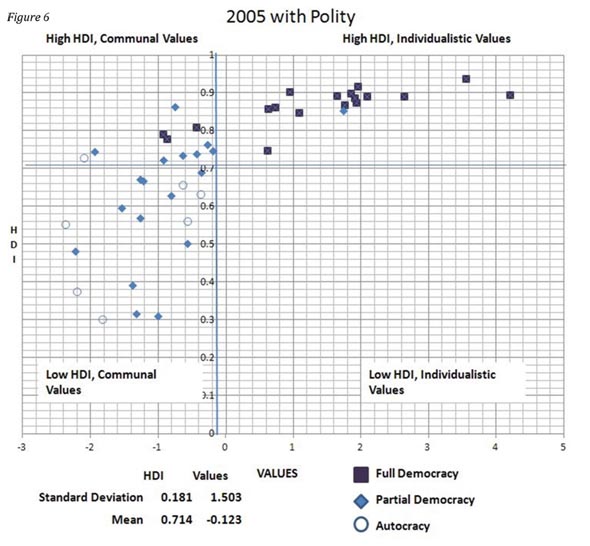
When broken down into four quadrants with the center being the average of the values and HDI all the democracies are in the area above the average HDI with the majority of them (90%) falling in the upper right hand quadrant. This area represents both an individualistic value preference and a high HDI. With the exception of one country, China in the 1990 and the 2000 graphs, the bottom right quadrant is empty.[9] With the exception of Saudi Arabia, which has a very high GNI, all the autocracies are in the bottom left hand quadrant, which represents a low HDI and communal values.
Section II. Conditional Values Theory – Needs and Values
In “Political Legitimacy and Values” I proposed a connection between the motivational aspects of values and political legitimacy. In essence values were the internal motivational component of political legitimacy. The motivational nature of values has its source in human needs. “Values serve as a socially acceptable, culturally defined way of articulating needs – a need for sex might be culturally reconstituted as a value for love. The expression and satisfaction of more biological needs can be reflected through culturally prescribed values, but these values are not the needs”[10]. Values are the way people articulate the pull that needs have on their actions.
Needs
So what are needs? “Needs are conditions within the individual that are essential and necessary for the maintenance of life and for the nurturance of growth and well-being. … Needs serve the organism, and they do so by generating wants, desires, and strivings that motivate whatever behaviors are necessary for the maintenance of life and the promotion of well-being and growth”.[11] Needs are one of the four sources of human motivation along with cognitions (learned beliefs, expectations, and self-concepts), emotions, and external events or stimuli. Human needs are universal.[12] While their manifestations may vary culturally, they are common to all people. Likewise, all people are compelled to satisfy their needs in a specific manner.
Abraham Maslow provides an outline which needs humans are compelled to satisfy first.[13] In "A Theory of Human Motivation" Maslow introduced what became commonly referred to as his Hierarchy of Needs. According to his theory there are five basic categories of needs; physiological, safety, belongingness, self-esteem, and self-actualization needs. Human beings attempt to satisfy these needs more or less in order starting with the physiological needs and ending with self-actualization. Physiological needs are those that keep you alive; air, food, water, warmth, etc. Safety needs are those that provide security from dangers. Safety needs are those that provide security from dangers: “security; stability; dependency; protection; freedom from fear, anxiety, and chaos; need for structure, order, law, and limits; strength in the protector”.[14] Belongingness needs include love and companionship but on a larger scale include defining your place in society: “ … the neighborhood, of one’s territory, of one’s clan, of ones own ‘kind’, one’s class, one’s gang …”.[15] Looking at the needs we have already discussed the need for relatedness would fall into this category. Self-esteem needs are those that establish the individual as important. Maslow saw this needs as having two components: “(t)hese needs are, first, the desire for strength, achievement, adequacy, mastery and competence, confidence in the face of the world, and independence and freedom. Second, we have what we may call the desire for reputation or prestige (defining it as respect or esteem from other people), status, fame and glory, dominance, recognition, attention, importance, dignity, or appreciation”.[16] Of the specific psychological needs we have discussed autonomy and competence fits into the self-esteem category as might also the need for power. Self-actualization means that the person has become who they always wanted to be: the ultimate goal to be achieved once all the needs were met was self-actualization – becoming all you were capable of being. “Musicians must make music, artists must paint, poets must write, if they are to be ultimately at peace with themselves. What human can be, they must be. They must be true to their own nature. This need we may call self-actualization”.[17]
When proposed (and in later works) Maslow established seventeen propositions that laid the foundation for his theory.[18] Six of these are important here and will be outlined in three pairs. First, Maslow did not feel that a compilation of all possible needs was possible, only general categories of needs that were related to each other by the type of benefit they provide the person. Second, Maslow felt that needs were common to all people but that cultural influences would change how needs manifested them in human behavior. Third, Maslow postulated that needs were satisfied in order, and as lower level needs were satisfied higher level needs would present themselves. However, this principle was limited by the probability of attainment. If satisfaction of the a higher level need appeared so far out of reach that the person could not attain it, he would not seek to satiate it. This point is of extreme importance to social change. Maslow felt that this was why certain people never chose to change their lot in life. “Attention to this factor of possibility of attainment is crucial for understanding the differences in motivations among various classes and castes with a given population and among different countries and cultures”.[19]
Maslow’s hierarchy presents a useful framework for some aspects of cultural change. Assuming that needs are a basis of societal change over the long term, one would expect to see institutions change their focus from trying to satisfy physiological needs, to safety needs, to belongingness needs, to self-expression, and finally to self-esteem needs. But I should also make it clear that Maslow provides only broad categories of needs and specific needs may cross categories. In addition, Maslow’s hierarchy does not preclude the idea that multiple needs from different categories are affecting individuals at any one time. Only that, when forced to choose between needs in a resource constrained environment, the highest level unsatisfied need is likely to be the one a person will seek to satisfy.
Maslow’s hierarchy has been attacked for being culturally biased toward western cultures and that the hierarchy does not hold true in non-western societies.[20] For example in Asia more communal ideals that can be associated with belongingness are predominant in the culture, self-determination was not the most important need – belongingness was. However, from a cultural perspective this falls in line with the Maslow’s theory. While self-determination may have a pull, it would not become the primary motivator until the potential to satisfy self-determination needs became a potential reality. Satisfaction of a lower level need – belongingness – would be more important until the potential for achieving self-determination became a reality.
Since Maslow’s original work in 1943 research on human motivation has altered some of the terminology originally used by Maslow. Belongingness is now studied as relatedness and Self-Expression is now identified as part of Autonomy needs.[21] In general I will use the terms Belongingness and Self-Expression to denote categories of needs and the terms Relatedness and Autonomy for dominant needs within those categories.
Values
Values are directly related to needs. “A value is an enduring belief that a specific mode of conduct or end-state of existence is preferable to an opposite or converse mode of conduct or end-state of existence.”[22] Values are the operationalization of needs. Shalom Schwartz agreed that needs are the source of values. Through a series of cross-cultural studies he developed a set of universal values.[23] He has arranged these values in circular continuum with like values next to each other and opposing values across from each other. Schwartz felt that a circular continuum best represented two aspects of values.[24] The first aspect was that some values were closely associated with others. These combinations of values tended to be more important to some people than other values. The second aspect was that some individual values had a polar opposite. For example, conformity stood in stark contrast to self-determination. These like values could be grouped into certain patterns, one of which was their association with a person’s general outlook on life and the future. Those values that were associated with reducing the anxiety or fear associated with uncertainty in life could be found on one side of the circle while those values associated that were not associated with the anxiety of life and were based more on growth and expanding life experience were found on the other side. Table 1 lists Schwartz’ revised list of universal values and Figure 7 displays them in the circular continuum.
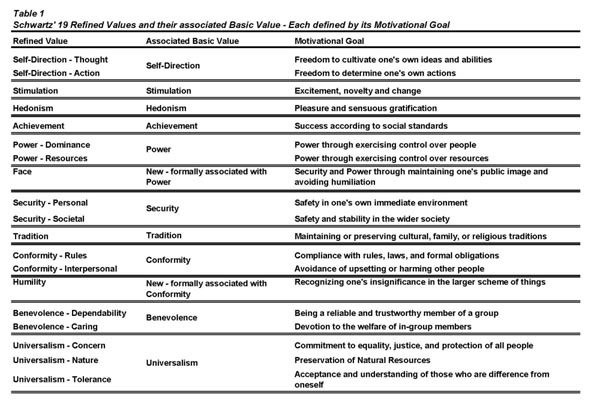
Values are arranged by societies in order of importance to create value systems they use to make decisions. For instance when given the choice between adhering to the traditions of the society or thinking or acting for yourself (Tradition versus Self-Direction), how you act will be influenced by which value you finds more important. Studies of national or societal level values by several researchers have disclosed two common value systems that were often related to political preference.[25] One had an “I” value system the placed individual wants and desires above group concerns and the other had a “we” value system and placed the belonging to, and identity with, the group higher than a member’s individual desires. The “we” value system I associated with traditional forms of political legitimacy like monarchy and theocracy I called the duty-based legitimacy. The “I” value system is aligned with liberal democratic legitimacy I dubbed rights-based legitimacy.
Looking at Figure 7 you can see how a connection between certain individual values and a value system with an “I” or a “we” slant can be formed. Value systems rank order values from most important to least important. Not all values will be higher or lower but when two values conflict, as with self-direction and conformity, one must be given greater import than the other or indecision will result. Likewise, values that lie adjacent to each other have a greater association. So, for example, if the highest three values were self-direction, universalism, and stimulation the collective value system would reflect this and the culture would idealize individual rights and individual identity. If the top three values were conformity, tradition, and security the culture would favor fitting into society. This alternative value system would lean towards one’s obligations to tradition and to conform to the rules of society rather than express yourself freely. Putting your desires ahead of the desires of the society would be seen as selfish and possibly criminal. The outer ring of the figure demonstrates this dichotomy.
Of course, the inner rings of the circle represent individual values and the middle ring represents whether the values are associated with fear and anxiety or whether they were anxiety-free and related to personal growth. The outer ring represents the value system/legitimacy type discussed further below. For example Schwartz combined aspects of his original ten individual values to create seven collective values.[26] Hofestede even went so far as to say that he did not believe that his collective values had any relation to individual values.[27] But it is easy to see how a set of associated individual values, when morphed into a societal value system, could have a preference for individual rights as opposed to communal duties. In fact, it seems counterintuitive that individual values preferences would play no role in which collective values a society prefers.
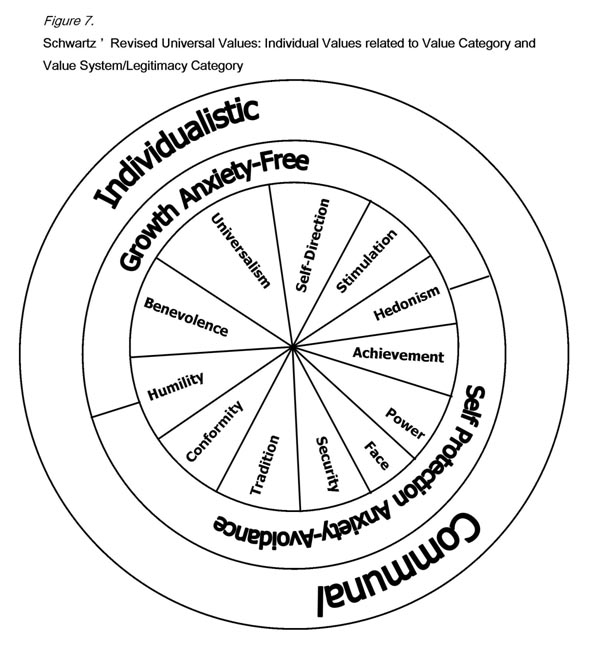
Values and Political Change
If we assume that values are tied to political legitimacy and therefore, political ideology, the next question is: what causes a shift in values that makes democracy more likely? Looking at figure 7 the answer is that the society’s values shift from Self-Protection Anxiety-Avoidance values to Growth Anxiety-Free values. Others have come to the same conclusion, although not by examining values. The idea that certain conditions must exist before democracy can emerge has been examined for some time. One of the more influential works on the subject was Seymour Martin Lipset’s “Some Social Requisites of Democracy: Economic Development and Political Legitimacy”.[28] The four primary factors that Lipset examined in the first part of that paper were industrialization, wealth, urbanization and education.[29] Since that time other factors have been offered for consideration like capitalism,[30] religion,[31] and interpersonal trust[32]. Still the basic connection between an increase in the overall wealth of a state and that state’s potential to successfully transition to democracy holds sway in the political science community even if the connection is not fully understood.
So what would wealth have to do with values? Directly nothing. But it is a proxy for something else – security. The basic theory would be that when a family is poor or living at or near a subsistence level they are most interesting in simply surviving. The anxiety associated with day-to-day living tends to make them more interested in one set of values over another. Even if that family begins to have security the specter of past hunger, decease, and poverty may continue to influence how children are raised. However, after a few generations of sustained security and wealth the family may feel comfortable enough to look feel safe and anxiety free. If this wealth is spread amongst a relatively large part of the society a new middle class is created. Education becomes possible. This new middle class begin to see other values as having relevance in their lives, perhaps even placing long held notions of conformity and tradition behind them in search of self-direction and stimulation, what might be termed western liberal democratic values. This speculative narrative is just that – theoretical speculation. But it is not far from the ideas of Schumpeter[33] and Inglehart and Welzel[34]. Inglehart and Welzel theory holds that there are two stages of value change before traditional values are replaced with the secular/rational values that support democratic institutions, so the basic concept is not without other theoretical support. But what I will do is attempt to demonstrate why these changes occur by looking at the process of value change. If needs are the source of values that changing needs should result in changing values and ultimately changing political ideology. Likewise, unless you change the needs the people are most concerned with and alleviate the anxiety associated with insecurity the values of the society will not change and neither will the political preference of the population.
Because they are based on needs, values are organized into a hierarchy with certain values being more important than others. When aggregated on a societal level they become value systems. “A value system is an enduring organization of beliefs concerning preferable modes of conduct or end-states of existence along a continuum of relative importance.”[35] To be able to rank a series of values along a continuum of relative importance, or some hierarchical structure you must have a list of values to work with. To create value systems individuals and groups of individuals arrange these values in rank order of relative importance.[36] This allows people to resolve conflicts. Value systems act as “principles and rules to help one choose between alternatives, resolve conflicts, and make decisions.”[37] Although these values are distinguishable certain values have complementary nature. For example Hedonism and Self-Direction are both centered on the desires of the individual above those of others where Conformity and Tradition tend to place the group over the individual.[38] Individuals and groups will tend to place complementary values at the center of their value system with all other values in a relatively lower status. This means that all groups recognize all the values. The values are universal. However, individuals, groups, and even societies will place greater import on certain values over other values.
Although both values and legitimacy can be viewed at from the perspective of the individual or the small group that is not the level that I am working at. The correlation between values and political legitimacy becomes clearer at the national level. The normative nature of values is distilled down when aggregated on the cultural or national level. While a number of different individuals or groups may have different value preferences a certain commonality must be realized at the national level if the political system is likely to survive. If there is too much division over fundamental issues then the result could be revolution or civil war. There have been several studies on national level value preferences that have already been correlated to political preference at the system level which will be discussed below. These demonstrate the commonality that is reached and maintained at these levels and it is at these higher levels that we will find congruence between legitimacy and values.
Political Legitimacy
Political Legitimacy is “precisely the belief in the rightfulness of a state, in its authority to issue commands, so that those commands are obeyed not simply out of fear or self-interest, but because they are believed in some sense to have moral authority, because the subjects believe they ought to be obeyed.”[39] As used here legitimacy is an attribute of the organization.
Legitimacy is obeyed because doing so is seen as the proper thing to do.
“Legitimacy is an internal value that is linked to personal feelings of obligation and responsibility to others. In these ways, it is similar to the moral values that are also an internal motivational guide to behavior. The influence of moral value upon behavior is like the influence of legitimacy in that both are internalized values that are take on by individuals as a personal responsibility – i.e., to obey legitimate authorities and to act in was consistent with personal moral values.”[40]
Values are the motivational source of legitimacy.[41]
The causal connection between needs and political systems occurs in four steps. First, needs create values. Since what a society feels is there most pressing need category, values are conditional based on that need category. Human needs may be universal but their satisfaction is conditional – connected to the needs the society believes they can succeed in satisfying. Second, these values are organized into value systems that tend to champion the needs the society is most interested in satisfying. Third, these value systems influence what a society sees as legitimate including political legitimacy. Finally, political legitimacy determines what type of political system a society will prefer or is likely to be stable based on the prevalent value system within the society. When needs and values are aligned with political legitimacy, the result is similar to Table 2.
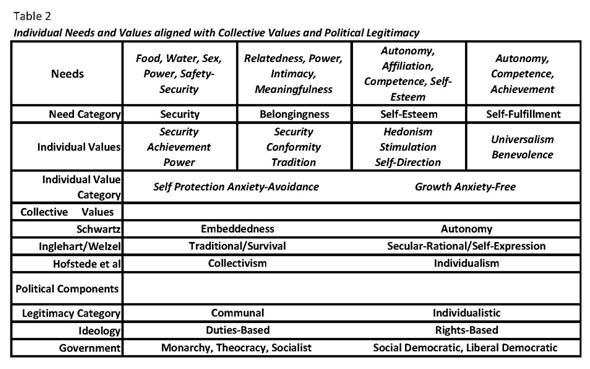
Section III. Implications of Conditional Values on Current Doctrine
If there were only one valid form of political legitimacy and that form was based on individualistic ideals then our current COIN and stability doctrine would probably be sufficient. Sections I and II provide the foundation for the idea that there is more than one valid form of political legitimacy. This means that liberal values and democratic governance are not going to be accepted by every single society. It explains why other forms of political legitimacy are going to have a more powerful influence on the population on a very basic human level than the individualistic legitimacy will have. This means that our current doctrine is likely to fail us in places where communal legitimacy is preferred by the populations. Based on this I make following two recommendations.
A. Clarify the nature and gradations of Political Legitimacy and our place in dealing with it in Stability and COIN operations.
Because out doctrine is based on democratization it is designed promote individualistic legitimacy. Legitimacy based in traditional tribal or other identity based systems are described as if they are invalid. For example the ADRP 3-07 Stability manual acknowledge the existence of “informal governance systems” that have the potential to contribute to stabilization and, in fact, may be “more popular than the formal government” but may also be seen as a threat by the Host Nation[42]. This informal governance system should be recognized as based in a valid form of legitimacy that will not easily be altered. Dealing with it as a threat will not increase stability. We need to be trained to understand and accept other types of legitimacy.
This failure to understand legitimacy leads to us believing we can purchase it. In those places where the political legitimacy we are promoting is incongruent with the culture’s preferred form solution we attempt to create legitimacy using governmental coercion. Governmental Coercion is any action that gets the population to acquiesce to a government they may not otherwise see as legitimate. Threatening the population is what most people think coercion is but bribery is another form of coercion.[43] So when we “[c]onduct local improvements designed to convince the populace to support the Host Nation government,” are we really building legitimacy or are we simply coercing the population to temporarily support the Host Nation government?[44] Providing services like water, trash removal, and electricity may be what a good government does but it will not create legitimacy. People who believe in the legitimacy of their government may go through long periods of deprivation and still support their leaders.
Legitimacy is not something that can be easily brought, but it might be possible to “borrow” it. In South Africa the democratic government works with tribal leaders in areas of the country where traditional communal legitimacy base on hereditist chiefdoms is still supported by the population.[45] The government pays the tribal chiefs to administer the territory their tribes have traditionally seen as their home yet is within the territorial boundaries of South Africa. This demonstrates that both forms of legitimacy can coexist in a single government if its leaders are willing to be creative. Such creativity does not appear to be permitted by our current doctrine.
If we pull out attempts to influence the populations preferred form of legitimacy and simply accept that we must work within the population’s preference our tasks in COIN and Stability could become more manageable. COIN would be streamlined to include only those tasks that the military is good at and leave out all the nation building tasks.[46] Likewise, Stability Operations would be designed to support the specific nature of the mission rather than trying to build education systems and support preconditions for successful long-term development. Our missions should be of a shorter duration and generally require a smaller footprint. It would no longer be afraid to impose a short term (one year or less) Transitional Military Government like we did after WWII in Germany and Japan, arguably our last two successful occupations. Since “U.S. forces will no longer be sized to conduct large-scale, prolonged stability operations”, removing democratization tasks from our doctrine moves us in the direction of streamlining stability tasks, potentially allowing for reduced mission scope both in operational duration and in force requirements.[47]
B. Create a separate doctrine for Democratization Support.
Creating a separate doctrine for democratization support would allow us to concentrate on understanding the various elements it takes maintain democracy. As I described in the section on Values and Political Change the nature of the transition to democracy is multifaceted. It involves the standard of living, education, and interpersonal trust levels of all members of the society as well as a myriad of other social and cultural systems. It is literally a change in the very fabric of society; the values and beliefs they hold dear; the ones they will fight and die for. As such it cannot be given the short shrift it has been in current doctrine.
Understanding the sociopolitical and socioeconomic nature of the transition from autocratic beliefs to democratic ones also allows the military planners to understand the limits of what can and cannot be done. After the swift and successful invasion of Iraq the military’s mission changed from finding weapons of mass destruction to supporting democracy in Iraq. While some commentators claimed that Iraq was ripe for democratization and it could be accomplished by transplanting democratic institutions others pointed out that Iraq meet none of the conditions normally associated with a democratic transition.[48] Had the military fully appreciated that nature of the task at hand they may have been in a better position to explain to U.S. political leaders cost in blood and treasure a comprehensive democratization effort would really require.
Doctrine on the nature of democratization is also needed because of inherent instability at the seam between communal and individualistic legitimacy. Even though both forms of legitimacy are founded in human needs and values the two are almost diametrically opposed. One has only to look at the French Revolution and the period that followed to see that the path from one to another is paved with blood. Therefore the potential for instability and insurgency to exist along this path is high. Understanding the nature of the transition may make our ability to assist others in making this journey less dangerous.
Conclusion
Spreading democracy, or, at a minimum, supporting countries that are either in the process of consolidation after a democratic transition or at risk of returning to an authoritarian regime, is still a valid national security interest. However, intermingling democratization tasks in COIN and Stability Operations doctrine only insures that we do neither mission well. In this paper I argued that there is more than one valid type of legitimacy and that having our doctrine not clearly recognize this creates the potential for our doctrine to be self defeating. The current bipolar nature of our doctrine must be cured by separating out democratization into its own doctrine.
End Notes
[1] U.S. Congressional Research Service. Democracy Promotion: Cornerstone of U.S. Foreign Policy? (RL34296 December 26, 2007), by Susan B. Epstein, Nina M. Serafino, and Francis T. Miko
[2] Wiechnik, Stan. 2013. “Political Legitimacy and Values”. Small Wars Journal, http://smallwarsjournal.com/jrnl/art/political-legitimacy-and-values .
[3] http://hdr.undp.org/en/statistics/hdi/
[4] http://hdr.undp.org/en/statistics/hdi/
[5] http://www.worldvaluessurvey.org/
[6] Inglehart, Ronald and Welzel, Christian. 2005. Modernization, Culture Change, and Democracy: The Human Development Sequence. Cambridge, UK; New York: Cambridge University Press.
[7] I am not saying that this can never happen. In cases of extreme threat to a country a communal nationalistic fervor could push a high HDI country back towards communal values. However, in this case what is driving that change is an increase in fear and therefore a greater concern for security needs normally associated with communal values.
[8] http://www.systemicpeace.org/polity/polity4.htm, accessed March 20, 2013.
[9] When other periods are used before or after 2000, China no longer falls to the left of this quadrant.
[10] Hitlin, S. and J. A. Piliavan. 2004. "Values: Reviving a Dormant Concept." Annual Review of Sociology Vol. 30: 359-393; 361-62. In part citing Rokeach. See also Schwartz, S. H., & Bilsky, W. 1987. “Toward a Universal Psychological Structure of Human Values.” Journal of Personality and Social Psychology, Vol 53(No. 3): 550-562.
[11] Reeve, Johnmarshall. 2005. Understanding Motivation and Emotion, 4th ed. Hoboken, NJ: Wiley: 5
[12] Deci, Richard M. and Ryan, Edward L. 2000. “The Darker and Brighter Sides of Human Existence: Basic Psychological Needs as a Unifying Concept.” Psychology Inquiry. Vol. 11, No. 4: 319-38; 328
[13] Maslow, Abraham H. 1943. “A Theory of Human Motivation.” Psychological Review, Vol. 50: 370-96.
[14] Maslow, Abraham H. 1970. Motivation and Personality. 2nd ed. New York: Harper and Row: 18.
[15] Maslow, 1970. p. 20
[16] Maslow, 1970. p. 21
[17] Maslow, 1970. p. 22
[18] Maslow, 1943; Maslow, 1970.
[19] Maslow, 1970. p. 12
[20] Gambrel, Patrick and Cianci, Rebecca. “Maslow’s Hierarchy of Needs: Does it Apply in a Collectivist Culture.” Journal of Applied Management and Entrepreneurship Vol. 8, No. 2 (April 2003): 143-61.
[21] Deci, 2000; Reeve, 2005.
[22] Rokeach, Milton. 1973. The Nature of Human Values. New York, Free Press: 5
[23] Schwartz, S. H., & Bilsky, W.;1987. See also Schwartz, S. H. 2011. “Studying Values: Personal Adventure, Future Directions.” Journal of Cross-Cultural Psychology Vol. 42, No. 2: 307-19; Schwartz, S. H., Jan Cieciuch, Michele Vecchione, Eldad Davidov, Ronald Fischer, Constanze Beierlein, Alice Ramos, et al. 2012."Refining the Theory of Basic Individual Values." Journal of Social Psychology 103, no. 4: 663-68.
[24] Schwartz et al., 2012.
[25] Hofstede, Geert H., Gert Jan Hofstede, and Michael Minkov. 2010. Cultures and Organizations : Software of the Mind : Intercultural Cooperation and Its Importance for Survival. 3rd ed. New York: McGraw-Hill; Schwartz, Shalom H. 2006. "A Theory of Cultural Value Orientation: Explication and Applications." Comparative Sociology, Vol. 5, No. 2-3: 137-82; Inglehart and Welzel, 2005.
[26] Schwartz, 2006.
[27] Hofstede et al., 2010.
[28] Lipset, Seymour Martin. 1959. "Some Social Requisites of Democracy: Economic Development and Political Legitimacy." The American Political Science Review Vol. 53, No. 1: pp. 69-105.
[29] Lipset, p.71.
[30] Lipset, Seymour Martin. 1994. “Some Social Requisites of Democracy Revisited.” American Sociological Review, Vol. 59. p. 1-22.
[31] Diamond, Larry; Plattner, Marc F.; & Costopoulos, Philip j. (Eds.).2005. World Religions and Democracy. Baltimore; John Hopkins Press.
[32] Fukuyama, Francis. 1995. Trust: The Societal Virtues and the Creation of Prosperity. New York, NY; Free Press; Muller, Edward and Seligson, Mitchell. 1994. “Civic Culture and Democracy: The Question of Causal Relationships.” American Political Science Review, 8(3), 635-652
[33] Schumpeter, Joseph A.2008. Capitalism, Socialism and Democracy. First Harpers Perennial Modern Thoughts Edition ed. New York: HarperCollins Publishers.
[34] Inglehart and Welzel, 2005.
[35] Rokeach p. 5
[36] Rokeach, p.14
[37] Rokeach, p.14
[38] Schwartz, Shalom H., and Galit Sagie. 2000. "Value Consensus and Importance: A Cross-National Study." Journal of Cross-Cultural Psychology Vol. 31, no. No. 4: 465-97
[39] Barker, R.. Political legitimacy and the state. 1990. Oxford New York, Clarendon Press ; Oxford University Press: 11
[40] Tyler, p. 390
[41] Wiechnik, Stan. 2013. Political Legitimacy and Values. Small Wars Journal. http://smallwarsjournal.com/jrnl/art/political-legitimacy-and-values (accessed February 12, 2014)
[42] U.S. Government. Stability, ADRP 3-07. August 2012. Washington, D.C.; Headquarters Department of the Army. p. 1-15, 16
[43] Wiechnik
[44] U.S. Government.. Tactics in Counterinsurgency, FM 3-24.2. April 2009. Washington, D.C.; Headquarters Department of the Army. p. 3-21
[45] Williams, Michael J. 2009. Chieftaincy, the State, and Democracy: Political Legitimacy in Post-Apartheid South Africa. Bloomington, IN; Indiana University Press.
[46] There is no doctrinal definition for “nation building” however RAND defines it as “the use of armed force in the aftermath of a conflict to underpin an enduring transition to democracy”. Dobbins, James, Seth G. Jones, Keith Crane, and Beth Cole DeGrasse. 2007. The Beginner’s Guide to Nation-Building. Santa Monica, Calif.: RAND Corporation.
[47] U.S. Department of Defense. 2012. Sustaining U.S. Global Leadership: Priorities for 21st Century Defense. Washington, D.C.: U.S. Government. http://www.defense.gov/news/defense_strategic_guidance.pdf
[48] See Diamond, Larry. 2004. “What Went Wrong in Iraq.” Foreign Policy, September/October. http://www.foreignaffairs.com/articles/60095/larry-diamond/what-went-wrong-in-iraq, for arguments that Iraq could be democratized if properly resourced and the rebuttal: Smith, Tony and Diamond, Larry. 2004. “Was Iraq a Fool’s Errand?” Foreign Policy, November/December. http://www.foreignaffairs.com/articles/60276/tony-smith-and-larry-diamond/was-iraq-a-fools-errand arguing that Iraq meets none of the generally accepted preconditions for democratization.
